Frequently Asked Questions (FAQ)
Why is water important?
Water is an essential nutrient that is vital to life. Poor hydration can harm physical and mental performance. Healthy and calorie-free, water is the perfect
hydrating beverage and an ideal alternative to sugary drinks, such as soda. When kids are thirsty, they should be reaching for water, not soda.
More information
Is this really an issue? Aren't kids able to get a drink water in schools now?
Yes, unfortunately, this is an issue! At first glance, people might think it a "no-brainer": of course kids can get water in schools. But, looking more closely, the situation is worse than many think. In California, a recent survey found that at least 40 percent of responding districts did not have access to free drinking water for students during school meals. As new laws come into effect that rid schools of sodas and other unhealthy beverages, it is vital to make sure that the healthy alternatives are easy and convenient. Ensuring that students have drinking water easily available and accessible is a key strategy to combating obesity and encouraging healthy habits.
"The latest research demonstrates that kids are actually not drinking enough water. Depending on their age and gender group, only between 10 and 60 percent of children drink the recommended amount of water. And, this research also suggests most kids are drinking sugar-sweetened beverages to hydrate themselves, rather than plain, unflavored water. The study concludes that more efforts are needed to decrease sugary drinks and promote plain water consumption."
See web news article: U.S. Kids Drink Too Little Water
See journal article: "Contributors of water intake in US children and adolescents: associaitons with dietary and meal characteristics - National Health and Nutrition Examiniation Survey 2005-6"
Aren't schools required to make water available?
In December 2010, President Obama signed the Healthy, Hunger-Free Kids Act of 2010. One of the provisions of this act was a requirement that schools make free drinking water available to students during school meals. In September 2010, California passed similar legislation. However, before this policy action in late 2010, there were no federal policies that required water to be available with school meals.
Most states probably have basic requirements that water be available on a school campus. For example, there is currently a requirement in California that there be one water fountain per 150 people on a school campus. However,
a 1999 memo from the Superintendent of Public Instruction found that the requirement was inadequate for the needs of schools.
Moreover, this requirement does not specify that water be made available to
students during meals, when it is most important that healthy alternatives
to sugary drinks be easily available and accessible. In fact, recent
data from California indicate that many students do not have access to
free drinking water during school meals. Therefore, the recently
passed legislation responded to a real need to promote water consumption
in schools.
More information
Can't schools in California opt-out of this requirement?
No. While the state legislation that was signed in September 2010 by Governor Schwarenegger included a district level opt-out provision, the federal requirement that was established in December 2010 contains no such opt-out provision and supercedes the state law. The federal guidance implementing the federal requirement communicates the expectation that all schools be in compliance by the 2011-2 school year.
Won't it cost schools a lot of money to make water available to students?
Not necessarily. Economic, cost-sensitive solutions exist. While installing many new water fountains could be prohibitively expensive, making water more available to students is not only solved by installing water fountains. In fact, water fountains might not even be the best way to get kids water. Imagine the difficulty of all kids in a cafeteria lining up for one water fountain.
But, low-cost alternatives exist. This could be pitchers full of ice and tap water and recyclable cups or water coolers with dispensers and cups.
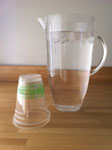
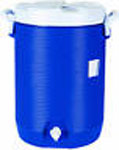
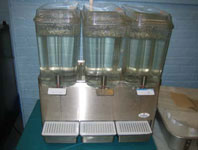
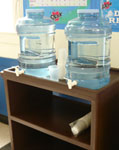
These water coolers can be filled up in the morning, kept chilled in a large, walk-in fridge, and rolled out to serve kids chilled tap water during their meals. Students have expressed a preference for chilled water rather than room temperature water.
While these solutions are inexpensive, they still do carry some cost. For schools that are unable to absorb these minor costs, federal reimbursement for school meals can cover the cost of these minor purchases, such as cups, pitchers, and dispensers, much as these reimbursements can be spent to purchase napkins, forks, and other meal-related accessories.
The Public Health Advocacy Institute just released a resource showing state-by-state electricity costs for vending machines and is available here. Their estimates are based on vending machines being situated indoors. In many California secondary schools, vending machines are outdoors, thereby increasing the energy costs. The energy expense associated with vended beverages is another good reason for encouraging the consumption of free tap water!
Are you pushing schools to sell more bottled water to kids?
No! In fact, we are pushing schools to serve free, tap water. For a variety of reasons, tap water is the preferred solution. Tap water is virtually free and, in most places, it is fluoridated and therefore has dental health benefits. Bottled water is more costly for schools and generates mountains of plastic bottle waste in addition to the energy required to transport these heavy bottles around the country. For more on the benefits of tap water over bottled water, click here or check out this poster on the environmental benefits of using the tap over the bottle.
If we have a couple of water fountains, is that enough?
It depends. Factors such as type of water fountain, number of students in your school, and number and placement of fountains all will determine if they are sufficient. Imagine a crowded lunch room with hundreds of students; two water fountains in the corner of the cafeteria is likely insufficient to meet the needs of the student body. For a smaller school or one with a number of easily accessible fountains where students eat meals, existing fountains might be sufficient.
Bottom line: one solution will not apply to all schools.
However, schools shouldn't focus on water fountains as the solution. They might be a costlier and less efficient system than some of the models described above. For long term planning, installing water fountains and water stations that have bottle fillers that can quickly dispense a good amount of water in a short time might be the ideal solution.
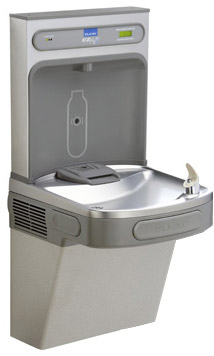
Isn't tap water unclean or unsafe?
In most places, no. Tap water is rigorously tested and subject to state and federal standards. Actually, tap water is subject to more testing than bottled water. Many brands of bottled water are, in fact, just filtered tap water.
However, in a small number of communities, tap water may indeed be unsafe. In these communities, residents likely know that their water supply is unsafe and take remedial steps, such as purchasing filters or even purchasing bottled water.
Schools with unsafe water supplies should obviously not serve tap water to students unless they install filtration systems that remedy the problem. Otherwise, these schools will have to purchase bottled water for students until the pollution problem is remedied.
For more on water safety, click here.
